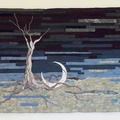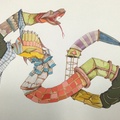In Japan, flower-arranging, known as ikebana or “living flowers,” is one of the most refined and spiritual of art forms. With its roots in the ritual offerings of flowers to the Buddha, ikebana is not merely an attractive natural decoration. A successful arrangement can capture the spiritual harmony of Heaven, Earth, and humanity. By selecting particular flowers to represent the current season and occasion and arranging them in a well balanced form, an ikebana practitioner can transform an interior space into a place of reflection and spiritual awakening.
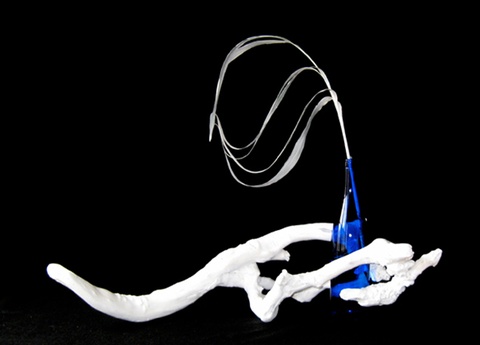
"Breeze" (Fusion Ikebana series) by Shizuko Greenblatt, 2008; mixed media sculpture, 22" x 32.5" x 13". | Courtesy of the artist.
Los Angeles-based artist Shizuko Greenblatt trained in this art form for many years, but only recently began creating sculptural works informed by the flower arranging tradition of her native country. As with traditional ikebana, her recent “Fusion Ikebana” series has the power to reflect, transform, and uplift the spirit.

"Rejuvenation" (Japanese Characters series), 2010/2011; acrylic and gold leaf, 36" x 48". | Courtesy of the artist.
For the last 20 years or so, Greenblatt has focused her artistic energies on expressionistic paintings that incorporate the calligraphy she learned as a child in northern Japan. Born into a samurai family, Greenblatt (née Murai) was exposed to calligraphy and other traditional art forms at a young age. “Many members of my family were very accomplished calligraphers. I am not as good as they are,” she explains modestly. She studied at Aoyama Gakuin University in Tokyo, and then moved to Los Angeles to continue her studies at UCLA. After 23 years working as an interior designer, she became a full-time artist and embraced the calligraphic brush with enormous vigor. Her Japanese Character paintings, in which powerful black ink brushstrokes combine with vibrant acrylic splashes, possess the spiritual energy of a Zen master’s scroll. Works such as Go Forward, Infinite Growth and Passion for Life derive their titles from the characters she includes in each of them and express not only her own emotions but also her intent to lift the spirits of those who view these paintings.
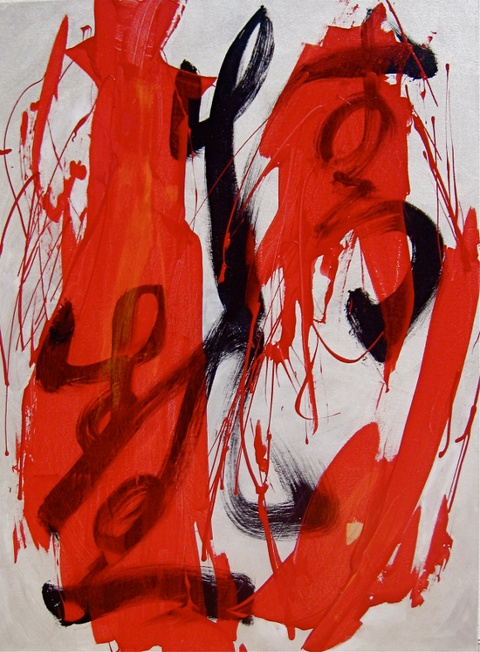
"Passion for Life II" (Japanese Characters series), 2010/2011; acrylic on canvas, 40" x 30". | Courtesy of the artist.
Greenblatt’s ikebana works evolved in part from her calligraphic paintings. For instance, there is clear visual connection between the sculptural work Vitality I and the painting Passion for Life II. The swirling black brushstrokes on the white ground of the painting are echoed in the sculpture by the painted black branch radiating out in all directions as if trying to escape the frame of the white grid. Red—the color of life, love, and celebration in the East and the West—washes over the black strokes in an abstract expressionistic subversion of traditional Japanese calligraphy. In the sculpture, the red vertical lines are more controlled and add a warm energy to the sculpture. Yet, the composition of a painted branch seemingly captured in a cage appears to challenge the ancient tradition of flower arranging. If this is ikebana, where are the flowers?
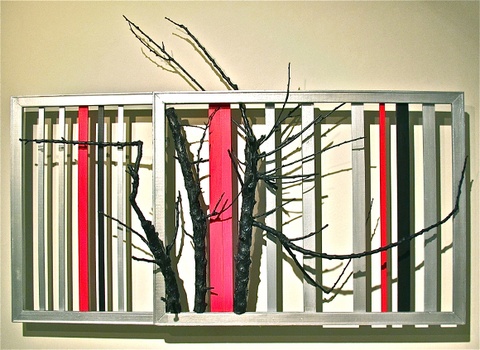
"Vitality I" (Fusion Ikebana series) by Shizuko Greenblatt, 2011; acrylic on canvas frames, branches and wooden rods, 42" x 60" x 14". | Courtesy of the artist.
There is a precedent for this approach to flower arranging in the Sogetsu School of Ikebana, which was founded in Japan in 1927 and has gained popularity worldwide. Sogetsu practitioners are encouraged to use materials other than flowers in their arrangements, and one of its recent leaders, artist and avant-garde filmmaker Hiroshi Teshigahara (1927-2001), considered ikebana a form of sculptural expression. He emphasized line, mass, and color over petals and leaves, so in Sogetsu floral arrangements, actual “living flowers” are not always required. Greenblatt first took classes in ikebana from a Sogetsu master while at art school in Tokyo. She continued her training in Los Angeles and eventually qualified to be a Sogetsu ikebana teacher. However, once she decided to pursue a career as an artist, she opted to take a break from ikebana.
In 2008, when Greenblatt became a member of the Los Angeles Art Association and was trying to decide which paintings to include in an exhibition, someone asked her why she didn’t include ikebana in her work. The suggestion was the seed that blossomed into her “Fusion Ikebana” series of sculptures. These works feature no cut flowers, water, or elegant ceramic container, but are instead assembled from branches, recycled wood, and found containers. By painting the wood and pairing it with objects of different colors and materials, she builds dramatic sculptural compositions, such as Breeze, in which painted white wood and blue glass are paired to evoke coolness. Like her paintings, these works often have titles such as Enthusiasm, Perseverance, and Hope. In Grace, a globular vase teeters precariously atop a tower built of several stories of recycled glass, jars, and sheets. A single vine curves downward out of the mouth of the glass towards the floor, shedding leaves in order to maintain its balance.
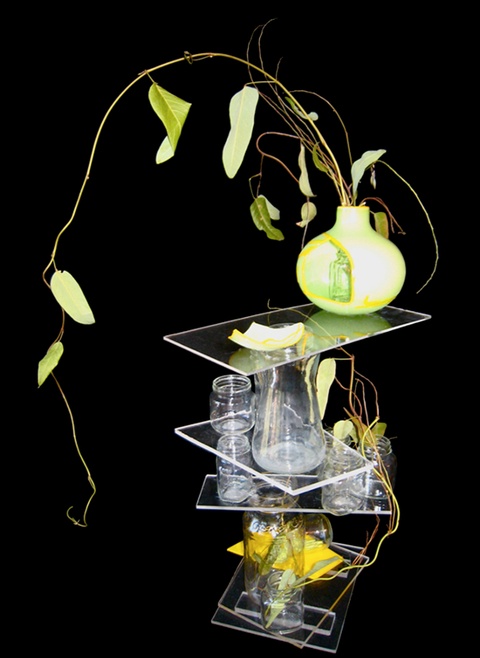
"Grace" (Fusion Ikebana series) by Shizuko Greenblatt, 2009; mixed media, 32" x 22" x 20". | Courtesy of the artist.
Greenblatt’s large-scale fusion ikebana installation “Growth of Civilization,” created for an exhibition at Gallery 825, pays homage to a traditional New Year’s Japanese ikebana arrangement of plum, bamboo, and pine (shochikubai). “I aim to activate and uplift the human soul,” she explains, “by the transformed sculptural elements and traditional Japanese symbolism.” The plum, bamboo, and pine branches are painted white, black, and red and stand upright in a white vase. The large and small fan shapes symbolize prosperity, and red and white represent celebration—all New Year themes. The bold black branch, reminiscent of a calligraphic brush stroke, creates a powerful anchor for the installation.

"Growth of Civilization" (Fusion Ikebana Series) by Shizuko Greenblatt, 2011; mixed media installation. | Courtesy of the artist.
In her recent installation work, Greenblatt unites her Japanese Character paintings and her Fusion Ikebana sculptures. In the work, Hope (2011), a black form, suggesting the devastation of the 2011 tsunami and earthquake in Japan, points towards a painting of lush green hills and a swaying white plum branch bearing delicate white paper flowers. At either side are large characters—“Overcoming” on the left and “Perseverence” on the right. On the central painting is the character “Hope,” reminding us that hope can always help us move forward. Though these ikebana works may not feature actual living flowers, they are animated by the energy and spirit of the natural world and cause us to reflect upon what it really means to be alive.

"Hope" (Fusion Ikebana series) by Shizuko Greenblatt, 2011; Installation, 8' x 8' x 17'. | Courtesy of the artist.
More of Shizuko Greenblatt’s work can be found on her website www.shizukogreenblatt.com.
*This was an article in the “Asian Accents” series that explored the diverse range of artistic influences from Asia in the arts and culture of Southern California. It was originally published on KCET Artbound on June 19, 2013.
© 2013 Meher McArthur / KCET


